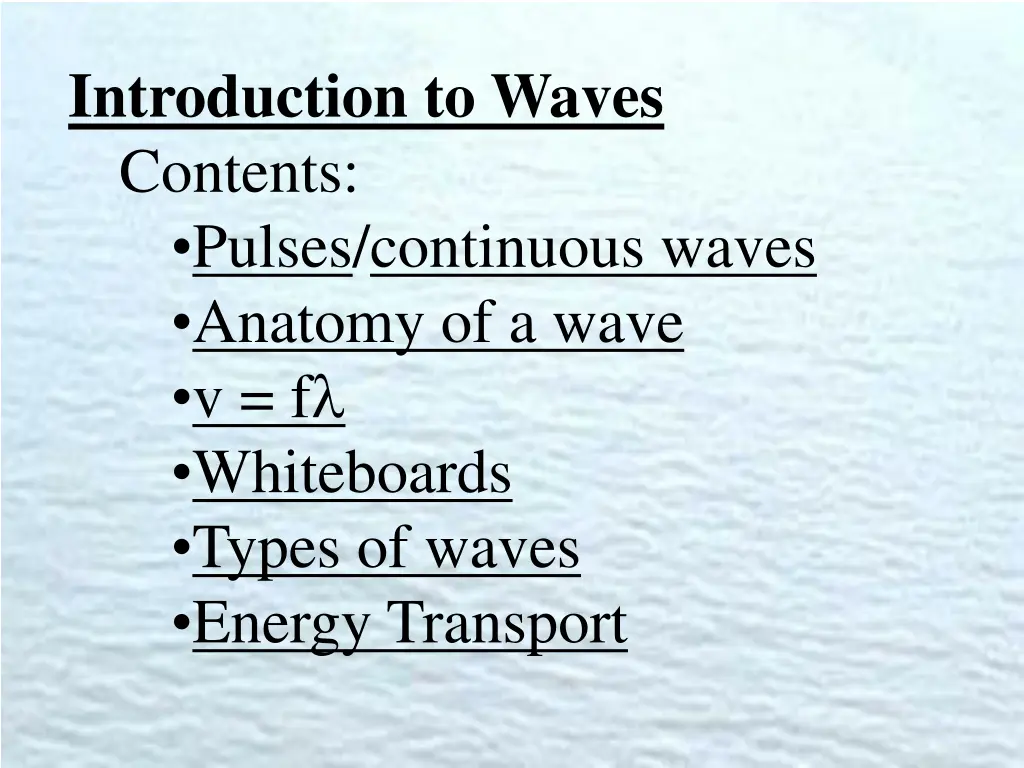
Understanding Waves: Anatomy, Demonstration, Formulas & Examples
Explore the fundamentals of waves, including pulses and continuous waves, anatomy of a wave, wave motion, important principles, wave formulas, whiteboards, and examples. Learn about wave characteristics, speed, frequency, and period through visuals and explanatory content.
Download Presentation

Please find below an Image/Link to download the presentation.
The content on the website is provided AS IS for your information and personal use only. It may not be sold, licensed, or shared on other websites without obtaining consent from the author. If you encounter any issues during the download, it is possible that the publisher has removed the file from their server.
You are allowed to download the files provided on this website for personal or commercial use, subject to the condition that they are used lawfully. All files are the property of their respective owners.
The content on the website is provided AS IS for your information and personal use only. It may not be sold, licensed, or shared on other websites without obtaining consent from the author.
E N D
Presentation Transcript
Introduction to Waves Contents: Pulses/continuous waves Anatomy of a wave v = f Whiteboards Types of waves Energy Transport
Wave Pulses Motion of wave Motion of medium (rope) Demo
Continuous waves Motion of wave Motion of medium (rope) Demo
Important principle #1 Waves move through the medium Medium just goes back and forth Sound and air Demo wave device
Anatomy of a wave fig 11-23 Medium - material through which the wave travels Amplitude - how big, bright, loud Wavelength - (Lambda - in m) Wave speed - v (in m/s) - characteristic of medium Period - T (Time for one wavelength to pass - in s) Frequency - (Waves/sec - in 1/s or s-1 or Hz)
Important principle #2 Wave speed depends on type of wave and medium Not on amplitude and frequency Demo big spring (change tension)
Anatomy of a wave Basic Wave formulas: f = 1/T (and of course T = 1/f ) v = f
Basic Wave formulas: f = 1/T (and T = 1/f ) v = f Example 1: What is the frequency of a wave that takes 0.12 s for the whole wave to pass by? f = 1/T = 1/0.12 s = 8.3 s-1 or 8.3 Hz Example 2: What is the wavelength of an A 440.0 Hz if the speed of sound is 343 m/s? v = f , = v/f = (343 m/s)/(440.0 Hz) = 0.780 m
Whiteboards 1 | 2 | 3 | 4 | 5 | 6 | 7
What is the period of a 60. Hz wave? f = 1/T T = 1/f = 1/(60 s-1) = .01666 = .017 s .017 s
What is the frequency of a wave with a period of 0.003906 s f = 1/T = 1/(.003906 s) = 256.0 Hz 256.0 Hz
What is the velocity of a 1.12 m wave with a frequency of 32 Hz? v = f = (32 Hz)(1.12 m) = 35.84 m/s = 36 m/s 36 m/s
What is the wavelength of a 89.1 MHz FM radio signal? MHz = 106 Hz v = c = 3.00 x 108 m/s (Speed of light) v = f = v/f = (3.00 x 108 m/s)/(89.1 x 106 Hz) = 3.367 m 3.37 m
What is the frequency of a sound wave that has a wavelength of 45 cm, where the speed of sound is 335 m/s v = f f = v/ = (335 m/s)/(.45 m) = 744.444 = 740 Hz 740 Hz
What is the period of a 12.0 m long radio wave? v = c = 3.00 x 108 m/s (Speed of light) v = f f = 1/T f = v/ = (3.00 x 108 m/s)/(12.0 m) = 25,000,000 Hz T = 1/f = 1/(25,000,000 Hz) = 4.00 x 10-8 s OR v = s/t, t = s/v = (12 m)/(3.00 x 108 m/s) 4.00 x 10-8 s
